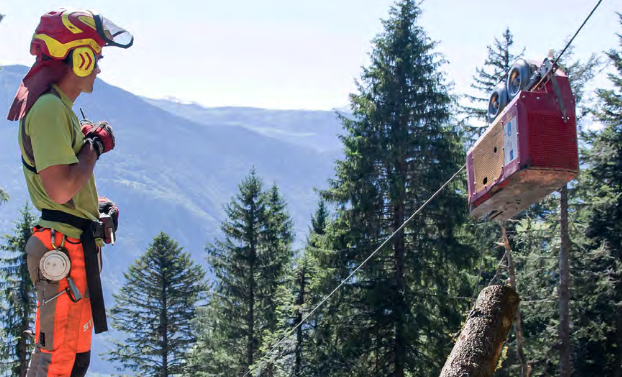Formicable: training professionals in cable skidding for a sustainable mountain timber industry
Forestry can be difficult in mountainous areas due to natural constraints, and some techniques, such as cable skidding, can be used to overcome steep slopes with minimal impact on soil and biodiversity. The Formicable project supported the training of professionals in the French forestry sector and the development of skills and specialised companies thanks to cross-border cooperation.
Advantages and challenges of cable skidding in the mountains
Cable skidding is a timber extraction technique that has significantly developed in mountain areas since the 1970s. This method is used to extract timber from steep forests without the use of machinery, such as skidders and tractors, but by conveying the trunks in the air with cables.
Cable skidding has many advantages for mountain sites. From an environmental point of view, cable transport provides better protection for forest soils, as it avoids the construction of roads accessible to large machines and the trampling of sensitive soils and shrubs by these same machines. The use of cables also reduces carbon emissions from forestry operations and limits noise pollution for wildlife. These benefits are regularly highlighted by sustainable timber labels, such as the PEFC label. From an economic point of view, cable skidding facilitates sustainable exploitation of mountain forests in the steepest plots and thus contributes to the development of local wood value chains.
However, this specialised sector is facing a progressive decline due to a lack of workforce. In France, the last cable training course closed in 2008 and less than 50,000 m3 of wood are now extracted using this technique in the Northern Alps. According to the French National Forest Office, there are only 16 companies specialised in this technique left in the country.
Taking advantage of cross-border cooperation to boost the timber sector
The Formicable project was carried out with the aim of revitalising the cable skidding sector in the French Alps, by training operators on this technique and drawing on the experiences of Alpine neighbours. Formicable took advantage of the knowledge and skills of the Swiss sector, which has remained very dynamic; 300,000 m3 of wood are extracted annually using this technique in the country.
From 2016 to 2019, several stakeholders in the timber industry on both sides of the Franco-Swiss border worked together to develop in France the skills adapted to the constraints of the mountains through cable skidding. To this end, professionals from both countries have developed several short technical training courses for workers in the sector. In addition, a certified training course was created, based on a common reference framework for professionals in the sector, in order to develop the training offer in the long term.
Formicable also produced a technical guide in French for companies and site managers, guiding them through the specificities of mountainous conditions, in order to encourage the maintenance of cable transport.

Results
Formicable helped to identify the French Alpine territories where forestry exploitation is only possible by cable and where a qualified workforce is needed for such exploitation. The training of apprentices and professionals supported the qualification of this workforce and thus contributed to the development of the forestry sector and the local wood value chain. The development of technical skills will also allow to benefit from the environmental advantages of cable skidding in the mountains, and to market products with sustainable wood labels.
The involvement of companies in this project, the communication carried out and the training provided contributed to raising awareness of the use of this technique and to supporting the development of local companies in the sector. In addition, certain actions aimed at the general public, such as a photo exhibition, helped to raise awareness of the importance of maintaining dynamic forest management in sensitive landscapes.